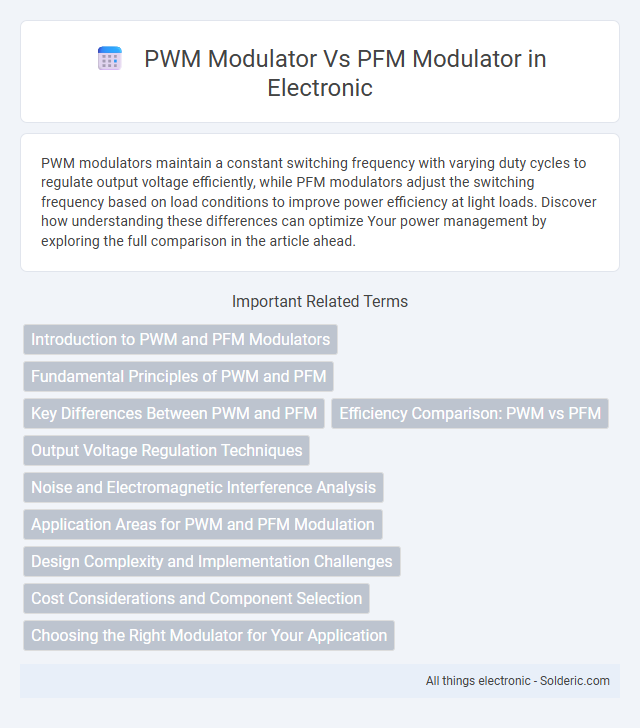PWM modulators maintain a constant switching frequency with varying duty cycles to regulate output voltage efficiently, while PFM modulators adjust the switching frequency based on load conditions to improve power efficiency at light loads. Discover how understanding these differences can optimize Your power management by exploring the full comparison in the article ahead.
Comparison Table
| Feature | PWM Modulator | PFM Modulator |
|---|---|---|
| Full Form | Pulse Width Modulation | Pulse Frequency Modulation |
| Control Parameter | Pulse Width | Pulse Frequency |
| Output Signal | Fixed frequency, variable duty cycle | Variable frequency, fixed pulse width |
| Efficiency | Lower at light loads | Higher at light loads |
| EMI (Electromagnetic Interference) | Predictable, fixed frequency | Less predictable, variable frequency |
| Complexity | Moderate | Higher |
| Applications | Motor control, LED dimming | Battery-powered devices, energy-saving circuits |
| Response Speed | Fast response | Slower response |
| Power Loss | Higher in idle mode | Lower in idle mode |
Introduction to PWM and PFM Modulators
PWM modulators regulate output by controlling pulse width to maintain a constant frequency, optimizing efficiency in power conversion applications. PFM modulators adjust pulse frequency by varying the switching frequency based on load conditions, enhancing efficiency at light loads. Your choice between PWM and PFM modulators depends on balancing load response, noise sensitivity, and power efficiency requirements.
Fundamental Principles of PWM and PFM
Pulse Width Modulation (PWM) controls the average power delivered to a load by varying the duty cycle of a fixed-frequency signal, maintaining a constant switching frequency while adjusting pulse width. Pulse Frequency Modulation (PFM) varies the switching frequency based on load demand, keeping the pulse width constant but changing the interval between pulses to regulate power. PWM offers stable frequency for reduced electromagnetic interference, while PFM enhances efficiency at light loads by reducing switching losses through frequency modulation.
Key Differences Between PWM and PFM
PWM modulators regulate output voltage by varying the pulse width of a fixed-frequency signal, ensuring consistent switching frequency and lower electromagnetic interference (EMI). PFM modulators adjust output by changing the frequency of pulses while maintaining a constant pulse width, optimizing efficiency at light loads but potentially increasing noise due to variable switching frequency. Key differences include PWM's fixed frequency and stable noise profile versus PFM's variable frequency with better light-load efficiency but higher EMI risk.
Efficiency Comparison: PWM vs PFM
PWM modulators typically offer higher efficiency at medium to high load conditions due to their fixed switching frequency, which minimizes switching losses. PFM modulators improve efficiency at light loads by varying the switching frequency, reducing power consumption during low demand periods. To optimize your system's performance, consider PWM for stable loads and PFM for applications requiring energy savings during light load operation.
Output Voltage Regulation Techniques
PWM modulators regulate output voltage by adjusting the pulse width of a fixed-frequency signal, ensuring precise voltage control through constant switching periods and variable duty cycles. PFM modulators achieve output voltage regulation by varying the frequency of pulses while maintaining a fixed pulse width, allowing for improved efficiency at light loads with variable switching periods. Both methods optimize voltage regulation, with PWM offering stable output and PFM enhancing power savings in low-load conditions.
Noise and Electromagnetic Interference Analysis
PWM modulators generate higher electromagnetic interference (EMI) due to their fixed switching frequency, causing prominent noise peaks at harmonics of the switching frequency. PFM modulators exhibit lower EMI by varying the switching frequency, spreading the noise spectrum over a wider range and reducing peak interference. Noise analysis reveals that PFM modulation is preferable for sensitive applications requiring minimal electromagnetic disturbances.
Application Areas for PWM and PFM Modulation
PWM modulators excel in applications requiring precise voltage regulation and high efficiency, such as motor control, power supplies, and audio amplification. PFM modulators are ideal for low-power devices like battery-operated gadgets and energy harvesting systems, where conserving power during light loads is critical. Your choice depends on prioritizing either high performance with stable output (PWM) or extended battery life with variable frequency control (PFM).
Design Complexity and Implementation Challenges
PWM modulators offer simpler design with well-established control mechanisms, making them easier to implement in systems requiring precise duty cycle control. PFM modulators introduce greater design complexity due to variable frequency operation, demanding advanced timing and stability management for efficient performance. Your choice between PWM and PFM modulators hinges on balancing implementation challenges with system requirements for power efficiency and noise sensitivity.
Cost Considerations and Component Selection
PWM modulators generally incur higher costs due to the need for precise timing components such as high-frequency oscillators and advanced control circuitry, whereas PFM modulators often utilize simpler components, reducing overall expenses. Component selection for PWM systems leans toward high-performance capacitors and inductors capable of handling consistent switching frequencies, while PFM systems prioritize components that efficiently manage variable pulse widths and load conditions. Cost optimization in PWM is driven by performance stability, while PFM modulator designs focus on minimizing complexity and component count to achieve budget-friendly solutions.
Choosing the Right Modulator for Your Application
PWM modulators provide precise control over output voltage and frequency, making them ideal for applications requiring stable power delivery and predictable response times, such as motor drives and audio amplifiers. PFM modulators excel in energy efficiency and reduced electromagnetic interference by adjusting pulse frequency instead of width, which benefits battery-powered and low-power devices like portable electronics and LED drivers. Selecting the right modulator hinges on balancing factors like power efficiency, noise sensitivity, load dynamics, and application-specific performance requirements.
PWM modulator vs PFM modulator Infographic

 solderic.com
solderic.com